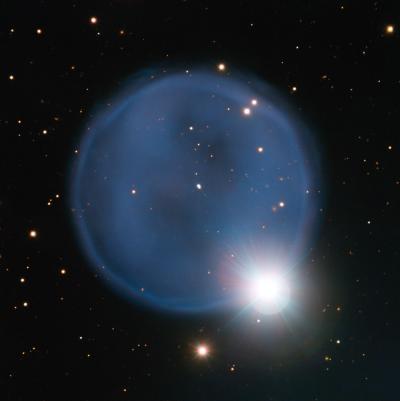Most stars with masses similar to that of our Sun will end their lives as white dwarfs; small, very dense, and hot bodies that slowly cool down over billions of years. On the way to this final phase of their lives the stars throw their atmospheres out into the space and create planetary nebulae, colorful glowing clouds of gas surrounding the small, bright stellar relics.
An captured by ESO's Very Large Telescope (VLT), shows the remarkably round planetary nebula Abell 33, located about 1,500 light-years from Earth. A round appearance is uncommon. Usually something - for example, the way the star spins, or if the central star is one component of a double or multiple star system - disturbs the symmetry and causes the planetary nebula to display irregular shapes.
The strikingly bright star, HD 83535, located along the rim of the nebula, creates a beautiful visual in this VLT image. This is just a chance alignment, HD 83535 lies in the foreground of the nebula about halfway between Earth and Abell 33, but it is in just the right place to make create the illusion a sparkling diamond ring.

Astronomers using ESO's Very Large Telescope in Chile have captured this eye-catching image of planetary nebula Abell 33. Created when an aging star blew off its outer layers, this beautiful blue bubble is, by chance, aligned with a foreground star, and bears an uncanny resemblance to a diamond engagement ring. This cosmic gem is unusually symmetric, appearing to be almost perfectly circular on the sky. Credit: ESO
The remnant of Abell 33's progenitor star, on its way to becoming a white dwarf, can be seen just slightly off-centre inside the nebula, visible as a tiny white pearl. It is still bright — more luminous than our own Sun — and emits enough ultraviolet radiation to make the bubble of expelled atmosphere glow. In this very sharp image the central star appears to be double. Whether this is a real association or just a chance alignment is not known.
Abell 33 is just one of the 86 objects included in astronomer George Abell's 1966 Abell Catalogue of Planetary Nebulae. Abell also scoured the skies for galaxy clusters, compiling the Abell Catalogue of over 4000 of these clusters in both the northern and southern hemispheres of the sky.
This chart shows the huge and sprawling constellation of Hydra (The Female Water Snake). Most of the stars that can be seen in a dark sky with the unaided eye are marked. The location of the faint planetary nebula Abell 33 is indicated with a red circle. The apparently very bright star on the rim of the nebula is HD 83535, an ordinary hot white star that happens to lie about halfway between the Earth and Abell 33. Although this star is easily seen in binoculars the nebula itself is a very dim object that can only be seen in larger amateur telescopes and is best viewed with an appropriate filter. Credit: ESO, IAU and Sky&Telescope
This image uses data from the FOcal Reducer and low dispersion Spectrograph (FORS) instrument attached to the VLT, which were acquired as part of the ESO Cosmic Gems program.





Comments